
Lance Allen and Catherine G. Rushton, Forensic Science Program
David Neff, Chemistry Department
Marshall University
 |
||||
Lance Allen and Catherine G. Rushton, Forensic Science Program |
||||
M.U. SEM Facility |
||||
. |
| .
|
|||||||||||||
|
Introduction: |
||||||||||||
| . | |||||||||||||
Materials and Methods: |
|||||||||||||
SEM/EDS Parameters |
Sample Preparation Matches produced by seven different match companies were analyzed. A list of the companies along with the samples corresponding to those match producers can be seen in Table 1. The samples were prepared by two methods. The second method produced a more homogenous sample. |
||||||||||||
Preparation Method 1 Table 1
|
Preparation Method 2 A razor blade was used to remove the entire match head from a match. The match head was ground with a mortar and pestle to homogenize the sample. This sample was placed between two glass microtome blades and pressed flat with a minimum pressure of 50 psi. Samples from five different matches of the same book were prepared for two of the match producers. |
||||||||||||
. |
|||||||||||||
|
|||||||||||||
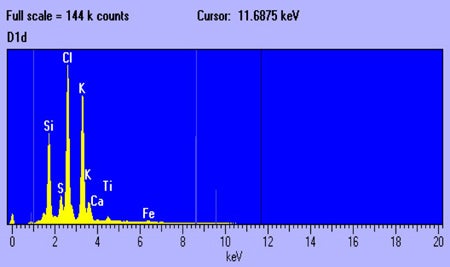 |
|||||||||||||
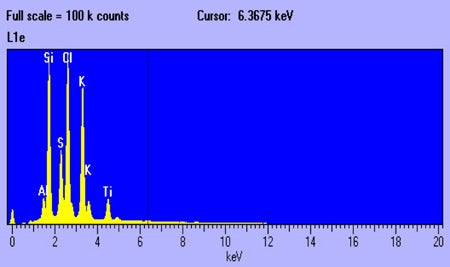 |
|||||||||||||
Fig. 1 Spectra of A1b, D1d, and L1e. Elements present are similar, but relative abundance differs. |
|||||||||||||
| Results: ... A spectrum was collected from five matches from each book for all seven match producer (ex. A1a ─ Ale). The major elements in all the matches were the same (silicon, sulfur, chlorine, and potassium), But spectra were visibly different based on relative amounts of major and trace elements. ... Energy windows were used to calculate the integral values of eleven different elements. Relative abundance ratios were calculated from the integrals of each element in relation to potassium. These ratios were compared by Principle Component Analysis (PCA). |
|||||||||||||
 |
|||||||||||||
Fig. 2 Dendrogram of the PCA analysis. Shows the amount of dissimilarity between the samples. |
|||||||||||||
| ... A large amount of variation can be seen in each set of match samples, thus not allowing for differentiation between one producer and another. Sample preparation method 2 was devised to improve uniformity of the sample, and reduce variation. Sample preparation method 2 was used to prepare more samples for U1 and L1. U1 was chosen because there was a large variability in the samples. L1 was chosen because the sample were similar to U1. It was hoped using preparation method 2 the U1 samples would have less variation and be distinct from the L1 samples. | |||||||||||||
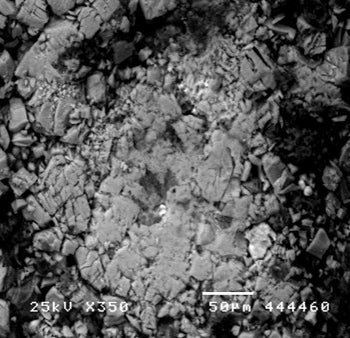 |
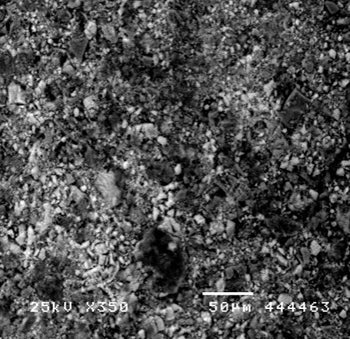 |
||||||||||||
Fig. 3 Lion Match Company sample (L1b) prepared by a flake of the match head cut off and pressed flat. |
Fig. 4 Lion Match Company sample (Lig) prepared by entire match head being ground and pressed flat. |
||||||||||||
| ... The particle size is much smaller in the sample ground with mortar and pestle (method 2), figure 4, than in the sample prepared by method 1, figure3. The ratios for the samples prepare by method 2 were used for more PCA analysis. | |||||||||||||
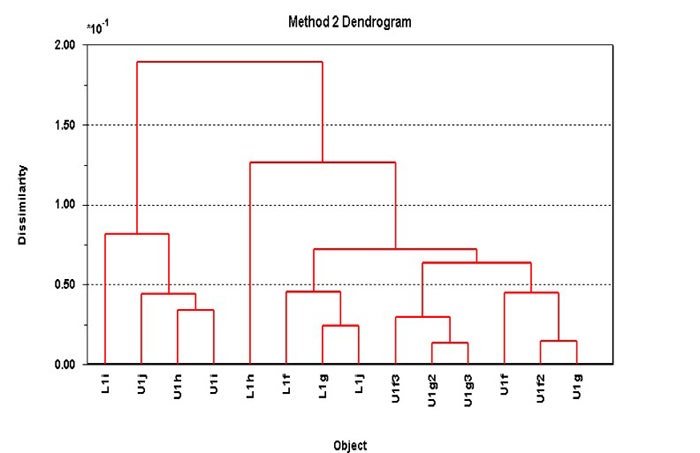 |
|||||||||||||
Fig. 5 Dendrogram of the PCA analysis of samples prepared by method 2. |
|||||||||||||
| Although the variation in each of the two sets (U1 and L1) decreased, the U1 samples still were not distinct from the L1 samples. This suggests reanalysis of all samples after being prepared by method 2 would reduce the variability in each set. | |||||||||||||
| ... | |||||||||||||
| . | |||||||||||||
| Conclusion: ... The spectra of some matches showed a visible difference in the amount and types of elements. These differences ranged from large variability in the amount of major elements to the presence or absence of trace elements. Even with the visible differences in many spectra, the variation in each match producer set made comparisons impossible. ... With the second method of sample preparation the particle size was significantly smaller. Thus, the homogeneity was improved and variations within a set reduced. While it has been shown that even with the second preparation method some matches are not distinct from others, groups of certain match producers may be distinct from other groups of match producers. ... Future work would include preparation of sample for the other five match producers using the second preparation method. These could then be analyzed by the SEM/EDS. The PCA analysis would then show if groups of match producers differ from other groups. |
|||||||||||||
Literature Cited
Andrasko, J. Identification of Burnt Matches by Scanning Electron Microscopy. J. Forensic Sci. |
Acknowledgments The authors would like to thank Dr Michael Norton for providing accessible and well equipped microscopy facilities, supported in part by NFS COBRE grant (period 2004-2009). We also appreciate the help of Dr. Graham Rankin with the PCA analysis and Dennis Ward with guidance on sample preparation. |
||||||||||||
|
|||||||||||||